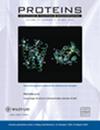负责将细菌粘附到其定植表面的粘附素结构域从伴生分裂结构域向外突出
IF 3.2
4区 生物学
Q2 BIOCHEMISTRY & MOLECULAR BIOLOGY
引用次数: 0
摘要
细菌粘附素会将宿主附着在细菌要定植的表面上。这种表面粘附是通过位于长粘附素分子远端的特定配体结合结构域实现的。然而,迄今为止,识别众多粘附素结构域中哪些是结构域,哪些是配体结合域一直是个难题。在这里,我们使用蛋白质结构建模程序 AlphaFold2 来预测这些 0.2-1.5 兆蛋白质的结构。之前解决的几个粘附素区域的晶体结构与模型非常吻合。大多数粘附素结构域通过其 N 端和 C 端以线性方式连接,而配体结合结构域则可以通过从一个伴生核心结构域中萌发出来而被识别,这样它们的配体结合位点就会远离粘附素的轴线,从而最大程度地暴露在它们的目标物上。这些伴生结构域通过将配体结合结构域向外突出而在其连续性上 "分裂"。这些 "分裂结构域 "大多是 β-三明治扩展模块,但其他结构域,如 β-硒状结构域,也能发挥同样的作用。对革兰氏阴性细菌序列进行的生物信息学分析表明,它们的 "毒中重复 "粘合蛋白中使用了多种配体结合结构域。其中许多结构域的配体尚未确定,但已知的配体包括各种细胞表面糖、蛋白质甚至冰。识别粘附素所结合的配体可以找到阻止细菌病原体定植的方法。将不同的配体结合结构域工程化到粘附素中有可能改变细菌结合的表面。本文章由计算机程序翻译,如有差异,请以英文原文为准。
Adhesin domains responsible for binding bacteria to surfaces they colonize project outwards from companion split domains
Bacterial adhesins attach their hosts to surfaces that the bacteria will colonize. This surface adhesion occurs through specific ligand‐binding domains located towards the distal end of the long adhesin molecules. However, recognizing which of the many adhesin domains are structural and which are ligand binding has been difficult up to now. Here we have used the protein structure modeling program AlphaFold2 to predict structures for these giant 0.2‐ to 1.5‐megadalton proteins. Crystal structures previously solved for several adhesin regions are in good agreement with the models. Whereas most adhesin domains are linked in a linear fashion through their N‐ and C‐terminal ends, ligand‐binding domains can be recognized by budding out from a companion core domain so that their ligand‐binding sites are projected away from the axis of the adhesin for maximal exposure to their targets. These companion domains are “split” in their continuity by projecting the ligand‐binding domain outwards. The “split domains” are mostly β‐sandwich extender modules, but other domains like a β‐solenoid can serve the same function. Bioinformatic analyses of Gram‐negative bacterial sequences revealed wide variety ligand‐binding domains are used in their Repeats‐in‐Toxin adhesins. The ligands for many of these domains have yet to be identified but known ligands include various cell‐surface glycans, proteins, and even ice. Recognizing the ligands to which the adhesins bind could lead to ways of blocking colonization by bacterial pathogens. Engineering different ligand‐binding domains into an adhesin has the potential to change the surfaces to which bacteria bind.
求助全文
通过发布文献求助,成功后即可免费获取论文全文。
去求助
来源期刊

Proteins-Structure Function and Bioinformatics
生物-生化与分子生物学
CiteScore
5.90
自引率
3.40%
发文量
172
审稿时长
3 months
期刊介绍:
PROTEINS : Structure, Function, and Bioinformatics publishes original reports of significant experimental and analytic research in all areas of protein research: structure, function, computation, genetics, and design. The journal encourages reports that present new experimental or computational approaches for interpreting and understanding data from biophysical chemistry, structural studies of proteins and macromolecular assemblies, alterations of protein structure and function engineered through techniques of molecular biology and genetics, functional analyses under physiologic conditions, as well as the interactions of proteins with receptors, nucleic acids, or other specific ligands or substrates. Research in protein and peptide biochemistry directed toward synthesizing or characterizing molecules that simulate aspects of the activity of proteins, or that act as inhibitors of protein function, is also within the scope of PROTEINS. In addition to full-length reports, short communications (usually not more than 4 printed pages) and prediction reports are welcome. Reviews are typically by invitation; authors are encouraged to submit proposed topics for consideration.
 求助内容:
求助内容: 应助结果提醒方式:
应助结果提醒方式:


